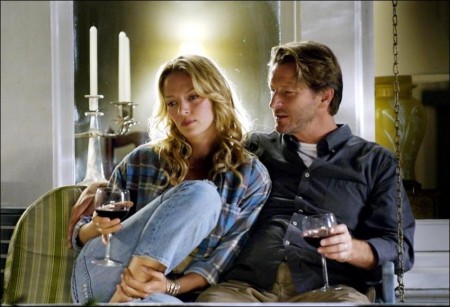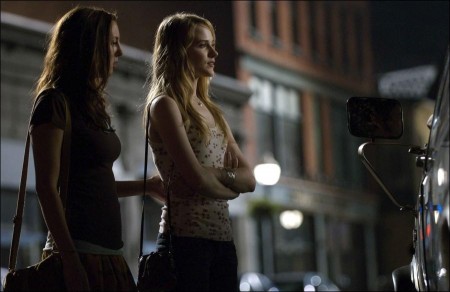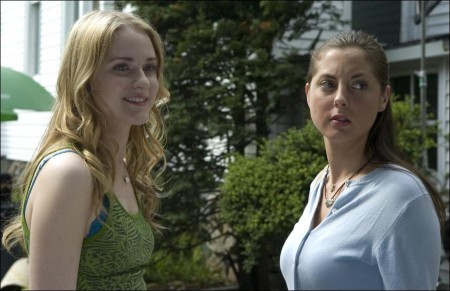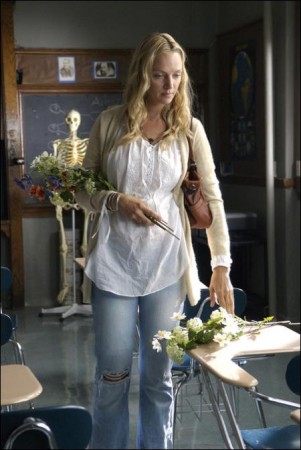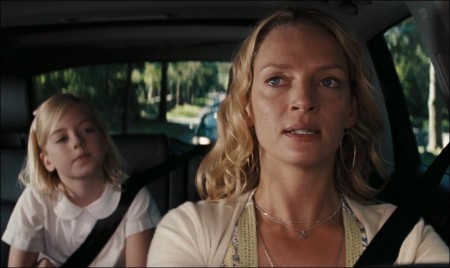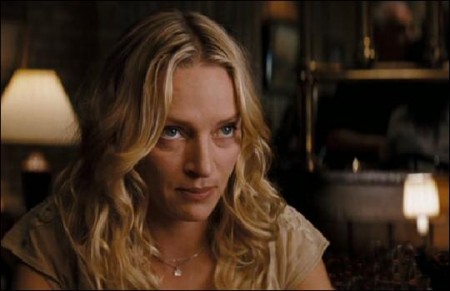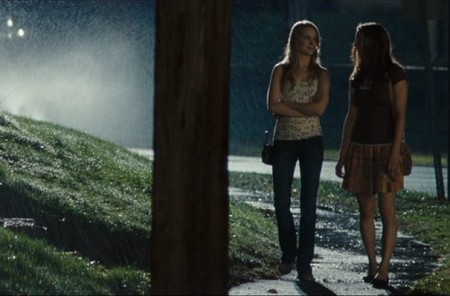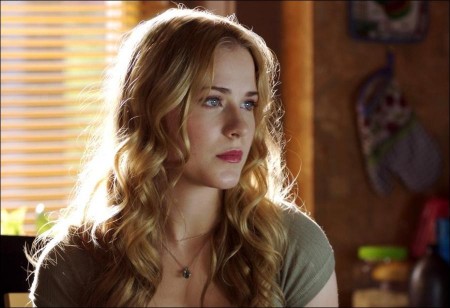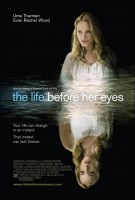Tagline: Diana’s life is not what it seems.
Based on the best-selling novel by Laura Kasischke, Life Before Her Eyes is a dramatic thriller about Diana (Oscar-nominee Uma Thurman), a suburban wife and mother who begins to question her seemingly perfect life –and perhaps her sanity– on the 15th anniversary of a tragic high school shooting that took the life of her best friend.
At seventeen, spirited and rebellious young Diana (Evan Rachel Wood) looks forward to grabbing hold of her future. Fueled by curiosity and desire, she is all appetite, constantly challenging her more reserved best friend Maureen (Eva Amurri) to take risks. The two tease each other about the roles they play-Diana describes them as “the virgin and the whore.”
Their lives are interrupted forever when the most normal of spring days is transformed by a senseless act of violence: a fellow student opens fire in their school and confronts Diana and Maureen and forces them to make an impossible flashpoint decision…
Fifteen years later, an older, more settled Diana (Uma Thurman) looks back on that day from the vantage point of a survivor. On the surface, her adult life is picture perfect. She is married to a popular professor and is raising an eight-year-old daughter who is sensitive and creative, even if she has inherited some of her mother’s rebellious streak. The coming of spring to her hometown is achingly beautiful, yet as the season change leads towards the fifteenth anniversary of the school shooting, Diana experiences increasingly disturbing undertones of distress.
When she thinks she sees a former teacher on the street-a man she knows was killed in the massacre-she nearly has a car accident. Her little girl redoubles Diana’s anxiety with a bad habit of running away and hiding at school. Diana may be troubled by guilt, or she may be affected by something more primal, more insidious. Her well-established life no longer seems quite real…
Meanwhile, we track young Diana’s trajectory leading up to the encounter with the gunman. Seen up close and personal, her rebellious attitude is revealed as less confident and far more troubled than she lets on. To sustain the dream of a future, Diana at seventeen finds herself running away from the consequences of the present…
When the adult Diana sees her husband apparently betraying her with a younger woman, Diana finds the fabric of her whole life tearing apart-there is nothing she can hold onto any longer. Caught up in this vortex, her panic escalates as her daughter goes missing. It is as if Diana has lost herself… her life disappearing before her eyes.
The film builds to an inexorable revelation that Diana is not the survivor she appears to be. Her life as she saw it was only the dream of a future-a mournful flash forward in the last moments young Diana has on earth.
About The Production
For director Vadim Perelman, the film of The Life Before Her Eyes began with reading Laura Kasischke’s novel. Having made his powerfully dramatic and visually rich feature film debut with the Oscar-nominated House of Sand and Fog, starring Ben Kingsley and Jennifer Connolly, Perelman found that her book inspired his instincts for literary material that provokes visual exploration: “The whole novel is like a song about these girls. It has a real element of magic to it. Laura is a poet and this was one of her very first works of prose.”
In her New York Times review, critic Erika Krouse emphasized the visual impact of author Laura Kasischke’s writing: “The Life Before Her Eyes evokes terror and redemption, shadows and light. Kasischke treads a delicate line with the precision and confidence of a tightrope walker. She reminds us to look hard at life, to notice its beauty and cruelty, even as it flashes before us and disappears.”
Yet her compressed and allusive style also posed a challenge for film adaptation. Perelman says of the book: “It doesn’t have a very linear structure or a conventional narrative… it has a very dreamlike quality to it. But that’s what made it so attractive to me: the challenge of bringing that to screen.” Laura Kasischke describes the central strategy of her novel: “It’s about dreams and about imagination-that splash of imaginative ecstasy or agony-and the tearing of the fabric of a dream.”
Rooted in the screenplay adaptation by Emil Stern, Perelman’s approach to the material was to express this sense of imminent magic and mystery, while still making sure the film was anchored in its own internal logic: “The movie as a whole is not a perfectly ordered experience with very clear causes and effects. Knowing that, I tried to echo that feeling on a scene-to-scene basis with little ellipses-for instance, Maureen is obsessed with a boy in her class and they talk about him all the time but you hardly see him.”
The audience is invited deep into the texture of how things happen. They learn very soon that Diana’s experience is a series of mirrored reflections, not a simple through-line. Tracking the eerie overtones that surround everyday events is a way to help draw them into her world – and to build suspense about the ways that world is being challenged.
Laura Kasischke’s inspiration for the book came from a connection she made between the tragic shootings at Columbine and a car accident in her small Midwestern town that claimed the life of three high school girls. “Everyone kept saying of those who died that `they had their whole lives ahead of them’ – all the potential that would never be realized, all the experiences that they would never have.”
She investigated her own sense of the overlap between dreams and memories: “Sometimes I have memories that seem less real for me than a dream I had last night. And sometimes I wake up from a dream which seems as though something has really happened to me. Was that less a lived piece of my life than some vague memories I have from the past?” Given that the central theme of the book has to do with “imagined life,” witnessing interplay of dream and memory further developed by seeing a film of her book being made is particularly powerful for the writer, “It’s fascinating to see people pretending to be characters that I pictured in my mind. It’s a strange sort of projection of my inner life out on the streets – and onto the screen.”
A core relationship for young Diana is her connection to her more conservative best friend Maureen, played by EVA AMURRI (The Banger Sisters, Saved). Vadim Perelman: “Young Diana is a rebel-she smokes, she’s always in trouble. On the other hand, Maureen is more timid; she goes to church and she’s just discovering how to be an adult, whereas Diana is ahead of her in that respect…Both have been raised by single mothers who just can’t supervise them, so they have to rely on themselves and, as their friendship evolves, on each other.” The bond formed with Maureen and what happens in their desperate confrontation with the shooter continues to resonate in the way the older Diana lives her life.
Uma Thurman observes: “The film is really the dream of a young girl about what it will be like to grow up and get past everything she’s struggled with.” She sees the moment of choice as a watershed between now and then. “The movie is about the way life can go from bumbling along, where all you’re concerned about is your boyfriend and your mom and your homework and your grades-totally mundane stuff-and then some horrific tsunami of human anger can just tear through a community and destroy it.”
Defining the turning-point situation in emotional, not political terms, Perelman declares: “The Life Before Her Eyes is not a film about a school shooting. It’s about how the incident guides people’s characters and about how these characters find a way to reaffirm their own lives.”
Since the production depended on finding two actresses who could convincingly play the same character, casting the two Dianas was a central challenge. Perelman had been tracking Evan Rachel Wood since her first breakout film role: “Evan was 15 when I met with her after the premiere of her film Thirteen. I told her, `I have a film that would be perfect for you.’ She was always the young Diana for me.” Wood remained committed to the picture for over three years. Producer Peyronnet points out that the young actress turned down other films to honor her interest in The Life Before Her Eyes, “as if the film were written for her.”
The task then became finding the perfect choice to play adult Diana, someone who could capture the mystery of the character without losing the specific edges that make this woman alive and accessible. Perelman describes his first encounter with Thurman: “When I met Uma I really felt she had a depth of character. She’s a mother herself and has a real understanding of life that is important to portraying this character.” Uma Thurman found the script beautifully written, with a dream-like feel that “put you into a sort of trance.”
She finds a entry to adult Diana in the way trauma has formed her sensitivity-how she takes the fears that remain from her ordeal and projects them into her concern for her own daughter Emma (played by the exceptional Gabrielle Brennan). She says the essence of her job as an actress in this movie is “to play the emotional thrust of the character – a real woman remembering something and trying to work out her life with her husband and child.”
In a telling phrase, she describes the particular terror that haunts her character Diana: “the vision of a life unlived.”
In calibrating the two actress’ performances so that audiences would believe that Thurman and Wood were playing the same character, Perelman found the giving of trust was a key tool: “First of all,” says Perelman, “Diana’s not my character any more. As soon as I give them the role, I relinquish it to them. And they become the vessel-all I can do is stand by.
and very gently steer them… Every day I would show both of them the dailies from the other’s performance. I wanted them to understand that they were really playing the same person. They both understood each other’s mannerisms and speech patterns-it looks like the most natural thing in the world but it took a lot of careful scrutiny.”
For Perelman, actress Eva Amurri wasn’t an obvious choice to play young Diana’s best friend Maureen. A child of the theater, daughter of Susan Sarandon and director Franco Amurri, Eva did not share Maureen’s aversion to risk or her natural quiet reserve: “She’s a self-assured, bubbly person. She’s not the meek, religious little girl at all. And I think that Eva’s true personality helped humanize Maureen. It gave her a kind of fire inside the character and highlights her heroism in this story.”
Evan Rachel Wood describes the interplay between young Diana and Maureen, “the free spirit” and “the good girl“: “They are complete opposites, but they somehow completely get each other.” She and Eva found that Perelman used their own growing on-set friendship to deepen the connection between the characters they play: “Sometimes Vadim wouldn’t even tell us the cameras were rolling and just let me and Eva go off and be ourselves.” Yet Perelman could be a tough taskmaster:
“He’s very blunt…I appreciate it because I’m hard on myself and it helps to have someone there obsessing over every little detail with you,” says Wood. Amurri concurs: “What Vadim does is very, very calculated. He knows exactly what he wants and he’s making the movie he wants to make every day. It’s really his baby.”
Thurman found the risk-taking theme extended to the decision to make the film itself: “I think there’s this real epidemic in cinema that nobody makes dramas any more. I love drama and so when I saw the boldness and bravura in House of Sand and Fog, I thought, `Here’s someone who said “I’m going to make a drama” and really did.” Produced and financed by Todd Wagner and Mark Cuban’s 2929 Productions (Good Night, and Good Luck; We Own the Night), The Life Before Her Eyes was the very epitome of an independent production. Says Thurman, “This is exactly what independent cinema is for, to do edgier material, to do it economically and smartly and to present it to the right audience. That’s how a complete vision can be created.”
Production Designer Maia Javan and Costumer Designer Hala Bahmet had worked with Vadim Perelman on House of Sand and Fog, while Director of Photography Pawel Edelman established his reputation on the international scene with Roman Polanski’s The Pianist, for which received an Oscar® nomination. He went on to film Taylor Hackford’s award-winning Ray. Together, these three formed the nucleus of Perelman’s creative crew, focusing on capturing the precise visuals and pervasive mood that the project demanded. Javan speaks of the director’s goal in having “an engaging contrast between the two time periods we are representing,” a difference that cannot be so pronounced as to throw the viewer out of the picture.
The world of the younger Diana has a warm, lush tone of remembered moments, a sense of classic richness like Vermeer, while the adult Diana’s life is portrayed in cooler tones that then grow more intense: “There’s a little bit more of a bright, vibrant, hyper-real springtime look that grows more extreme – abundant, mad, blossoming – as the fabric of her life starts to unravel.” These visual links need to be felt by the audience without having too much attention drawn. “We wanted to be very clever, but never appear clever.”
Although fifteen years separate the two time periods, it is always springtime in The Life Before Her Eyes. Yet even when the locations are the same, Evan Rachel Wood’s spring has to come across as different from Uma Thurman’s. Among the references Perelman brought to his visual team were macro nature photography, as well as highly saturated Japanese period photography.
The Connecticut locations were particularly valuable, because the places were fresh, yet steeped in history and character. Javan says: “We really found the landscape here. We were almost offered too many choices for what we wanted.” The only set built on this show was the school bathroom where the Diana / Maureen confrontation with shooter takes place. The set needed to have the real of a real place, but to allow for special effect, firearms, exploding sinks and a considerable amount of standing water. Mirrors were constructed to work two-way, so that the reflections would not betray the crew at work and multiple mirror images could capture an “infinity effect.”
“The set was lined on both sides,” Javan reveals, “ten feet wide with huge mirrors.” The dramatic action of The Life Before Her Eyes pivots on the suspense of what really goes on in this room; it was critically important for the Perelman and his creative team that the view we have of this action is as complex and as resonant as the dramatic fulcrum demands. Javan describes the bathroom set as “a real bridge – a portal between all the worlds of the film.”
Music plays a key role in integrating the emotional suspense of the story. Two-time Academy Award-winner James Horner had worked with Perelman on House of Sand and Fog, for which his music received an Oscar® nomination. Collaborating again on this new picture, Horner brings his vast range of experience in working with notable filmmakers in a wide range of projects to the challenges of a story that deals so deeply with issues of time and place and has a mystic component while never losing its basis in reality. The score builds upon complex elements of sound design, all targeted at drawing the audience deeper into the experiences of both Dianas, and into the way their viewpoints eventually overlap.
Vadim Perelman: “I wanted to make a film that was first and foremost, deeply rooted in reality. And then a horrific event shatters that reality. And the shards of it reflect something almost supernatural. The Life Before Her Eyes has classical elements of drama and it’s a mystery-an internal one. Usually movies that feature violence-like thrillers or police procedurals-they first diagnose the problem, develop an explanatory myth, and then rectify it. I wanted to make a movie where the reason for the violence was not the main question but rather, `What effect does the violence have on the people who go through it?’”
Production notes provided by Magnolia Pictures.
The Life Before Her Eyes
Starring: Uma Thurman, Evan Rachel Wood, Eva Amurri, Brett Cullen, Gabrielle Brennan, Lynn Cohen, Nathalie Paulding
Directed by: Vadim Perelman
Screenplay by: Emil Stern
Release Date: April 18th, 2008
MPAA Rating: R for violent and disturbing content, language and brief drug use.
Studio: Magnolia Pictures
Box Office Totals
Domestic: $303,439 (63.5%)
Foreign: $174,738 (36.5%)
Total: $478,177 (Worldwide)
